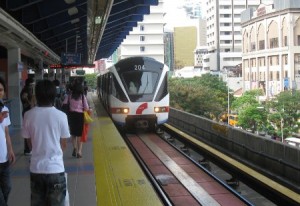I remember when I became a committed mass-transit rider as a traveller. Sitting in Bangkok’s horrific Friday afternoon gridlock, watching motorcycles driving down the sidewalk beside me, hawkers waving unknown foodstuffs at our window. Baking hot, and going nowhere, I glanced up to see the city’s monorail zip by, past the buildings and traffic.
An hour later we finally reached our hotel, just a few kilometres away (this was before we had our Bangkok bearings, and relied on cabbies for advice- bad move). As we walked into the hotel, I noticed the LRT station right at the head of the street. The next day, it took me five minutes to move the same distance as my cab ride the day before- for far less.
I’ve sworn off cabs now unless absolutely necessary. And proximity to a public transit system is one of my keys for selecting accommodations in a city I’m visiting.
I’ve become a devoted fan of mass transit systems, and pretty successful using them in Bangkok, Singapore, Kuala Lumpur, Vienna, Paris, London, and many other places. I’ve noticed many common elements that make it easier to understand and use them.
Here then, for newbies, are some tips for getting inside- and using- mass transit rail systems.
1. Don’t panic. Rail systems are usually the most modern, efficient means of moving people in a city. Trust they are designed to be easy to understand and make sense for everyone, including you. Most are made by Western companies, so they usually follow familiar rules and procedures. And English is common in signage, the computer systems, and automated announcement systems. Plenty of staff are usually on-hand to offer advice, especially to lost foreigners.
2. Read up on the system beforehand. Wikitravel often has good reference information about rail systems for cities, and many systems have English online guides. That can help you understand the system before you set foot on it. No doubt systems can be complex. Many have interconnecting monorail, subway, bus and even boat connection points. But getting the big picture beforehand makes it easier once you get on the ground.
3. Understand the system logic. Each rail route normally consists of two lines, one in each direction. Each line is usually named after its terminus station. Figure out which station you want to stop on which line, and follow the signs to the proper platform.
You can make a game out of it. In Bangkok, if I wanted to go to the downtown shopping district from my hotel, I had to get on the southbound, Mo Chit line. So I made a word game. “To buy mo’ chit, I need to go in this direction.” Corny, but it worked.
The system is usually consistent. To get on a train, you often have to place the ticket into the pass-gate, and collect the ticket after it is scanned to open the gate. It takes a few seconds. When you get off the train you again place the ticket in the pass-gate, but it stays in the machine the second time.
4. Bring small change into the station. You don’t want to be trying to change the equivalent of a $100 bill at the tellers’ to buy a $2 ticket. Also, take advantage of the all-day and multi-day passes. They save you both money and time trying to work out how much each individual trip you’re taking will cost.
5. Use Automatic Machines – it’s tempting to use the human tellers, but they often can be confused by your English request. Use the automatic machines if there’s any sort of lineup at the staffed booth. The computer systems often have an English option you can select.
6. Avoid Rush Hour: If possible, try not to use the system for the first time at rush hour. Off-peak hours are a great time to take a few moments to get familiar with station architecture (which is usually repeated throughout the system), read the system maps, buy tickets, etc. You also don’t want to be trying to fit yourself and your luggage into a packed cabin filled with sweaty office workers just wanting to get home. Pro-tip: the end of the train is often less crowded than the middle.
7. Follow the crowds. Not sure where the exit is? A good clue is where everyone else is going. Signage, again, is designed to help you find where you want to go. Get to know local words, like Keluar (Exit) in Malay- though again, English is common in most stations. Keep your head up. Note which pass-gates are closed, which are not. Stick to the left hand side of the escalators. Often directions are colour-coded on the floor. If you need to orient yourself, get off to the side, out of the flow of traffic.
8. Don’t be shy. Ask staff or fellow commuters- pointing, and saying the name of your destination, in an enquiring tone, usually works in any language. I usually confirm with a local before I board a train, even if I’m pretty sure I’m going the right way.
9. There’s one exception: Rome :-) None of this applies to the mass rail system in Rome, which was apparently designed by madmen.
10. Sit back, relax, enjoy. The great thing about travelling on trains is you can watch the world go by outside. You can see the city’s sights from a perspective you don’t usually see. It’s quick, easy, usually air-conditioned, and exciting. It’s clean and far safer than most other forms of transport.
And you can feel superior to those poor saps stuck in cabs in the gridlock on the streets below.

John Boivin is new to the blogosphere but not to writing. He worked as a print, radio and web journalist for more than 25 years until his retirement in 2010. He is now indulging in an old passion, landscape painting, as well as a new one, travel. He lives in Whitehorse, Yukon, Canada with his family.









